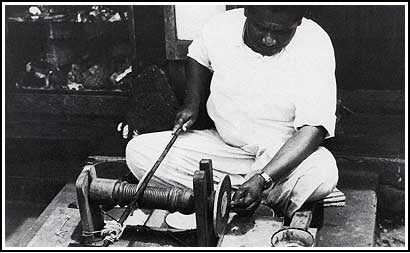Innovating Past Traditions April 24 2016
Sri Lanka has historically been a believer of tradition. It is therefore no surprise that the gem faceting industry is almost as old as the gem mining industry. A gemstone attains its beauty and value only once it is polished and faceted and until the early 1970s much of it was executed through traditional artistry and inherited skill.
 The ‘Hanaporuwa’ was the traditional tool to cut and polish many of the sapphires and diamonds found in the rivers and foothills of Sri Lanka. It utilized a bow and a steady hand to spin a flywheel that could be used to carefully shape a gemstone into an individual hand crafted masterpiece. However, as globalization grew and access to international markets flourished, the demand for perfectly cut and polished gems outgrew the performance inefficiency and lead times of an ancient art.
The ‘Hanaporuwa’ was the traditional tool to cut and polish many of the sapphires and diamonds found in the rivers and foothills of Sri Lanka. It utilized a bow and a steady hand to spin a flywheel that could be used to carefully shape a gemstone into an individual hand crafted masterpiece. However, as globalization grew and access to international markets flourished, the demand for perfectly cut and polished gems outgrew the performance inefficiency and lead times of an ancient art.
As a result, the industry evolved with the advent of technology to enhance precision and performance. Widespread adoption of advanced computer assisted faceting machinery enabled Sri Lanka to generate a ‘cut above the rest’ and hence gained global recognition in precision free size and calibrated cutting of diamonds and colored gemstones. Soon, the likes of Cartier and Rolex were employing the rapidly growing industry to generate cuts as small as 1/3rd of a millimeter with little to no tolerance for error in an assortment of their signature pieces.
Today, the gem faceting industry directly employs over 20,000 cutters throughout the island nation and over 5,000 of them are dedicated to diamonds or precious gemstones. As the influx of these natural gemstones grew, policies intended to preserve the sustainability of the industry were also set in place. Sri Lanka, along with 41 other nations, have agreed to ratify the Kimberly Process Agreement which enforced legislation that prohibited the trade of conflict diamonds that would be used to finance weapons and warfare in conflict areas.
The advent of technology and the willingness of the gem faceting industry to embrace it has aided the growth and well-being of many cutters, policy makers and retailers in Sri Lanka. This advancement remains to be a poster child for many other industries in this developing nation as it highlights the importance of respecting innovation and change over outdated traditions.
